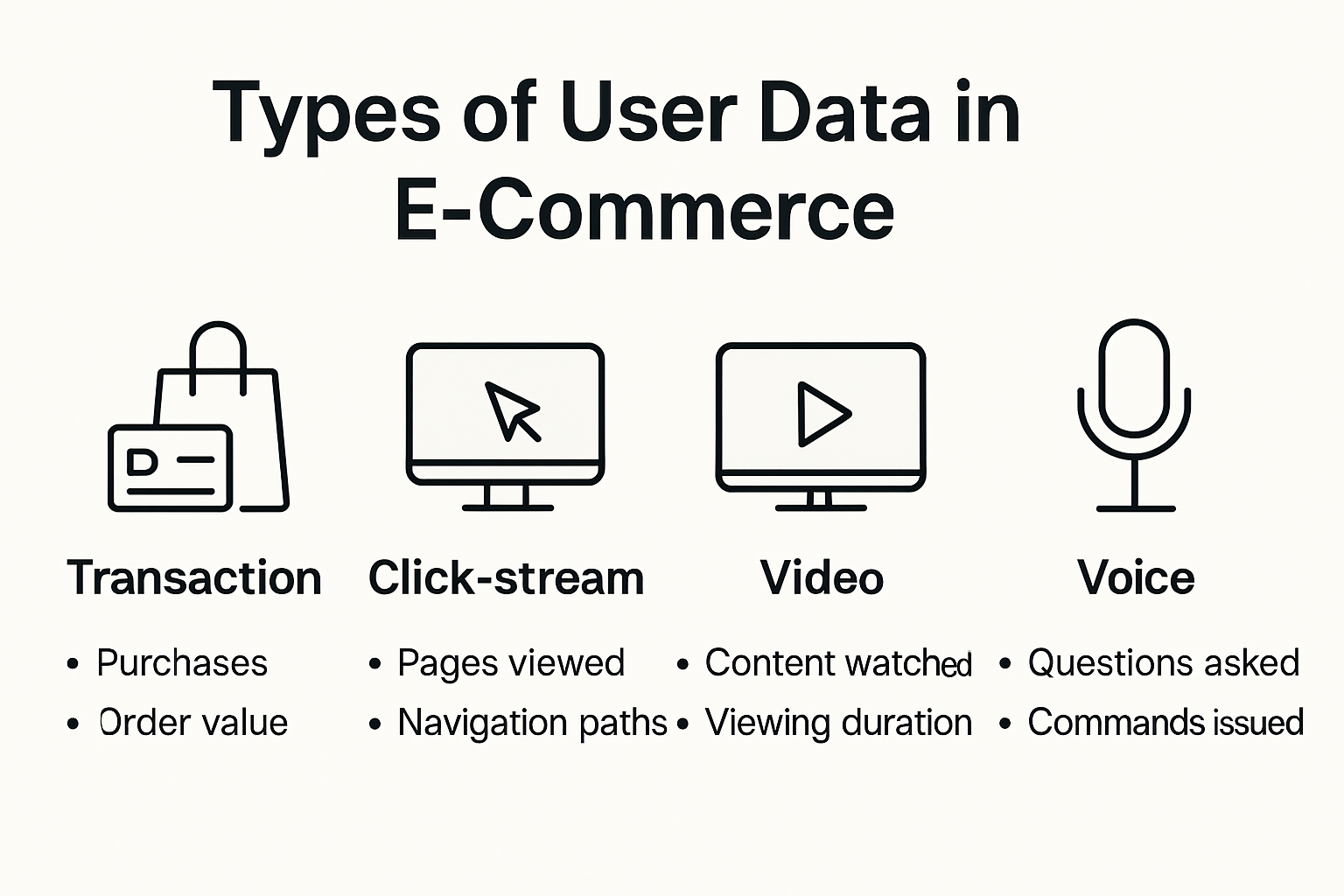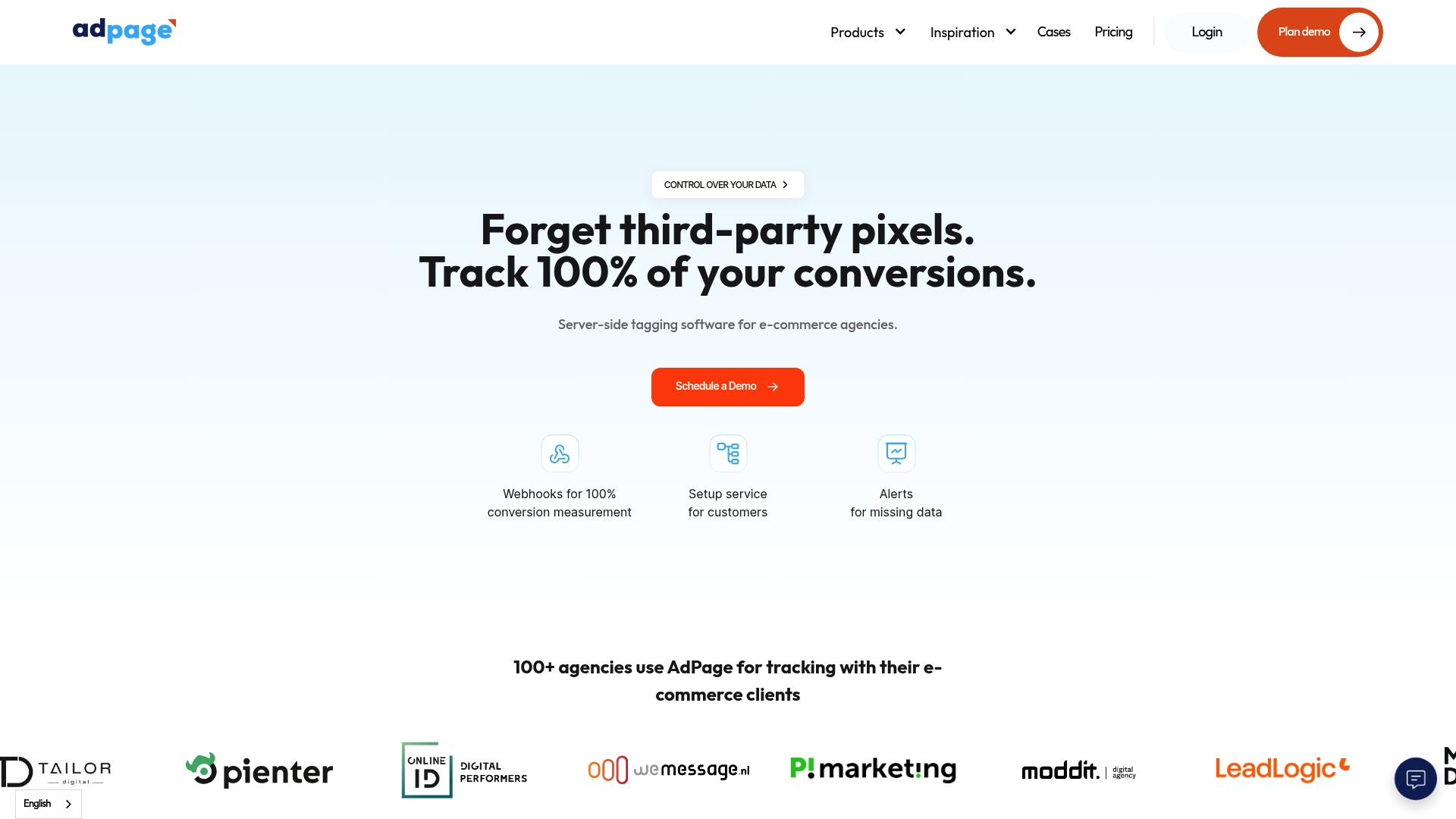Everyone in e-commerce talks about collecting user data to stay ahead and predict what customers want. Yet more than 60 percent of businesses admit they do not actually know how to transform all that data into stronger sales or bigger customer loyalty. Most people assume gathering mountains of stats is the hard part. In reality, interpreting that data in a way that creates real growth is what separates thriving brands from those drowning in numbers.
Table of Contents
- Understanding The Types Of User Data
- Key Methods To Analyze User Behaviour
- Turning User Data Insights Into Actionable Steps
- Common Mistakes To Avoid When Interpreting Data.
Quick Summary
| Takeaway | Explanation |
|---|---|
| Understand various data types | Transaction, click-stream, video, and voice data each provide unique insights into user behavior. |
| Implement advanced analytical techniques | Use sophisticated methods like cohort analysis and machine learning for precise behavior predictions. |
| Focus on actionable insights | Transform user data into customer segmentation and personalized marketing strategies for improved engagement. |
| Avoid common data interpretation mistakes | Establish clear goals and ensure data quality to prevent misunderstandings and misaligned analyses. |
| Develop a strategic implementation framework | Create a structured method to continuously adapt business strategies based on evolving user data patterns. |
Understanding the Types of User Data
In the dynamic world of e-commerce, how to interpret user data has become a critical skill for businesses seeking to understand and predict customer behavior. Modern digital interactions generate an extensive array of data points that provide profound insights into consumer preferences, purchasing patterns, and engagement strategies.
Comprehensive Categories of User Data
User data in e-commerce encompasses multiple sophisticated dimensions beyond simple transactional records. Research from SpringerLink categorizes e-commerce data into four primary types: transaction data, click-stream data, video data, and voice data. Each category offers unique perspectives on customer interactions and experiences.
Transaction Data: This foundational data type includes detailed customer profiles and comprehensive sales transaction information. It reveals critical patterns such as purchase frequency, average order value, product preferences, and customer lifetime value. By analyzing transaction data, businesses can segment customers, predict future purchasing behavior, and design targeted marketing campaigns.
Click-Stream Data: Representing digital footprints across websites and social media platforms, click-stream data provides granular insights into customer journey mapping. Research published in the National Center for Biotechnology Information highlights that consumer browsing logs capture essential interactions including page views, time spent on specific product pages, navigation paths, and abandoned cart information.

Below is a summary table comparing the key categories of user data in e-commerce and what each provides.
| Data Type | Description | Key Insights Provided |
|---|---|---|
| Transaction Data | Sales transactions, customer profiles, order details | Purchase patterns, segmenting, lifetime value |
| Click-Stream Data | Digital footprints, browsing logs, navigation flows | Journey mapping, page views, friction points |
| Video Data | User engagement with videos, product demonstrations | Emotional response, content engagement |
| Voice Data | Customer service audio, verbal interactions | Sentiment, frustration levels, communication |
Advanced Data Collection Methodologies
Beyond traditional data collection methods, modern e-commerce platforms are leveraging advanced techniques to gather more nuanced user insights. Video and voice data represent emerging frontiers in understanding customer experiences. These data types capture non-verbal communication, emotional responses, and contextual interactions that traditional metrics might miss.
For instance, video data can track user engagement with product demonstrations, while voice data from customer service interactions provides insights into sentiment, frustration levels, and communication effectiveness. These advanced data types complement traditional metrics by offering a more holistic view of customer experiences.
Strategic Data Interpretation Approaches
Interpreting user data requires a sophisticated, multi-dimensional approach. Successful e-commerce businesses do not merely collect data but transform it into actionable intelligence. This involves integrating multiple data sources, applying advanced analytics techniques, and developing predictive models that anticipate customer needs.
Key strategies include:
- Contextual Analysis: Understanding data within broader customer journey contexts
- Predictive Modeling: Using historical data to forecast future behaviors
- Segmentation: Creating precise customer groups based on comprehensive data insights
By adopting these approaches, businesses can move beyond reactive strategies to proactively design experiences that resonate with their target audience. The goal is not just to collect data but to derive meaningful, strategic insights that drive customer satisfaction and business growth.
Key Methods to Analyze User Behaviour.
Analyzing user behavior requires sophisticated approaches that transform raw data into actionable insights. E-commerce businesses must deploy strategic methodologies to understand customer interactions, predict preferences, and optimize engagement strategies.
Comprehensive Behaviour Analysis Frameworks.
Research exploring the AARRR framework reveals a structured approach to understanding user behavior across different stages of customer interaction. This model breaks down user engagement into five critical phases: Acquisition, Activation, Retention, Revenue, and Referral.
By dissecting user logs through this modular lens, businesses can track precise changes in customer behavior. Each stage provides unique insights:
- Acquisition: Understanding how users discover and enter the platform
- Activation: Measuring initial user engagement and first meaningful interactions
- Retention: Tracking user return rates and sustained platform usage
- Revenue: Analyzing conversion patterns and monetary interactions
- Referral: Examining user recommendations and organic growth mechanisms
The following table outlines the five stages of the AARRR framework and their focus in user behavior analysis.
| Internship | Focus | Example Insights |
|---|---|---|
| Acquisition | User discovery & traffic sources | Channel performance, user demographics |
| Activation | Initial engagement & interaction | Onboarding success, first purchase rates |
| Retention | Ongoing usage & return visits | Repeat customer rate, session frequency |
| Revenue | Conversion & purchase analysis | Order values, conversion funnel bottlenecks |
| Referral | User-driven growth & sharing | Referral traffic, customer advocacy |
Advanced Analytical Techniques
Cohort analysis research offers another powerful method for examining user behavior. This technique groups users based on shared characteristics or experiences within a specific timeframe, enabling businesses to identify nuanced trends in customer awareness and loyalty.
Machine learning techniques provide an additional layer of sophisticated behavior analysis. Studies demonstrate that advanced algorithms can classify user engagement levels by analyzing complex metrics such as event counts, purchase revenue, and interaction patterns. Decision tree models, for instance, can predict user behavior with remarkable precision, helping businesses anticipate and personalize customer experiences.
Strategic Behaviour Interpretation Methods
 Successful user behavior analysis goes beyond mere data collection. It requires developing comprehensive strategies that transform statistical insights into actionable business intelligence. Key approaches include:
Successful user behavior analysis goes beyond mere data collection. It requires developing comprehensive strategies that transform statistical insights into actionable business intelligence. Key approaches include:
- Mapping user journeys across multiple touchpoints
- Identifying friction points in customer interactions
- Creating predictive models for customer preferences
- Developing personalized engagement strategies
By integrating these methodological approaches, e-commerce businesses can move from reactive data interpretation to proactive customer experience design. The ultimate goal is not just understanding user behavior but creating seamless, intuitive interactions that anticipate and exceed customer expectations.
Turning User Data Insights into Actionable Steps
Transforming user data insights into concrete strategic actions represents the critical bridge between raw information and meaningful business improvement. Successful e-commerce organizations understand that data analysis is not an endpoint but a continuous process of refinement and adaptation.
Customer Segmentation Strategies
Research from OpenStax highlights the power of k-means clustering, an advanced machine learning technique for customer segmentation. This method enables businesses to categorize users into distinct groups based on nuanced purchasing behaviors, preferences, and interaction patterns.
By implementing sophisticated segmentation approaches, businesses can develop highly targeted strategies:
- Persona-Based Marketing: Creating tailored communication for specific customer groups
- Personalized Product Recommendations: Designing precise suggestions based on segmentation insights
- Dynamic Pricing Strategies: Adjusting pricing models according to customer segment characteristics
Conversion Optimization Techniques
Comprehensive research on e-commerce traffic sources underscores the importance of targeted improvements across digital platforms. Key focus areas include mobile optimization, browser compatibility, and streamlining the checkout process.
Practical steps for converting insights into actions involve:
- Analyzing exit rates across different devices
- Identifying potential friction points in user journeys
- Implementing responsive design principles
- Simplifying transaction processes
Strategic Implementation Framework
Effective data insight translation requires a structured approach. Businesses must develop a systematic method for converting analytical findings into operational improvements. This involves creating a feedback loop that continuously monitors, analyzes, and adapts based on emerging user data patterns.
Critical components of this framework include:
- Regular performance metric reviews
- Cross-departmental collaboration
- Agile response mechanisms
- Continuous learning and adaptation
The ultimate objective is not merely collecting data but creating a dynamic, responsive business ecosystem that evolves in real-time with customer needs. By treating user data as a living, breathing resource, e-commerce businesses can develop increasingly sophisticated, user-centric strategies that drive engagement, satisfaction, and long-term growth.
Common Mistakes to Avoid When Interpreting Data.
Navigating the complex landscape of data interpretation requires precision, critical thinking, and a strategic approach. E-commerce businesses frequently encounter pitfalls that can significantly distort their understanding of user behavior and compromise decision-making processes.
Misalignment of Goals and Analysis.
Research from NetSuite emphasizes the critical importance of establishing clear objectives before diving into data analysis. Many organizations make the fundamental error of collecting and analyzing data without a well-defined strategic purpose.
Common goal misalignment issues include:
- Undefined Business Objectives: Collecting data without specific strategic outcomes
- Irrelevant Metric Selection: Tracking metrics that do not directly impact business performance
- Lack of Contextual Understanding: Interpreting data in isolation without broader business context
To mitigate these risks, businesses must:
- Clearly define analytical goals before data collection
- Involve key stakeholders in establishing measurement criteria
- Ensure data analysis directly supports strategic business objectives
Data Quality and Visualization Challenges
Search Engine Journal highlights significant challenges in data interpretation, particularly regarding data quality and visualization. Poor data representation can lead to catastrophic misunderstandings and misguided business decisions.
Critical challenges include:
- Inconsistent data formatting
- Inadequate data validation processes
- Misleading or complex visualizations
- Overlooking backend data sources
Professional data interpretation requires:
- Standardizing data collection methods
- Implementing robust validation protocols
- Creating clear, intuitive data visualizations
- Integrating multiple data sources for comprehensive insights
The table below lists common data quality and visualization challenges along with best practice solutions to address each.
| Challenge | Best Practice Solution |
|---|---|
| Inconsistent data formatting | Standardize collection methods |
| Inadequate validation processes | Use robust validation protocols |
| Misleading or complex visualizations | Create clear, intuitive charts/graphics |
| Overlooking backend data sources | Integrate and regularly audit all data inputs |
Analytical Approach and Resource Allocation.
The eMarketing Institute warns against common analytical misconceptions that can derail effective data interpretation. Businesses often make critical errors in their analytical approach and resource allocation.
Key pitfalls to avoid:
- Expecting immediate results from data analysis
- Relying on a single analytical tool
- Underinvestment in analytics capabilities
- Failing to continuously update analytical methodologies
Successful data interpretation demands:
- Patience and long-term perspective
- Utilizing multiple analytical tools
- Investing in skilled data professionals
- Maintaining a flexible, adaptive analytical strategy
By recognizing and addressing these common mistakes, e-commerce businesses can transform data interpretation from a potential source of confusion into a powerful strategic advantage. The goal is not just to collect data, but to develop a nuanced, holistic understanding that drives intelligent business decisions.
Frequently Asked Questions
What types of user data are crucial for e-commerce success?
User data in e-commerce mainly includes transaction data, click-stream data, video data, and voice data. Each type provides unique insights into customer preferences and behavior.
How can advanced analytics help in interpreting user data?
Advanced analytics techniques such as cohort analysis and machine learning can provide precise behavior predictions, allowing businesses to better understand customer needs and refine marketing strategies.
What are the common mistakes to avoid when interpreting user data?
Common mistakes include misalignment of goals and analysis, ignoring data quality, and employing inadequate analytical methods. Clear objectives and robust validation processes are essential for accurate interpretations.
How can I turn user data insights into actionable strategies?
To convert insights into actions, employ customer segmentation strategies, optimization techniques for conversions, and a structured framework for implementation that adapts based on ongoing user data analysis.
Ready to Turn User Data into Real E-commerce Growth?
Feeling lost in a sea of numbers is a common challenge, especially when your business survival depends on clear action from data. The article explains how simply collecting transaction data and click-stream events is not enough. If you are struggling with misaligned goals, missed conversions, unreliable analytics or overwhelming data quality issues, you are not alone. True e-commerce success begins with accurate data collection and insightful interpretation, yet many brands waste time and budget because of traditional tracking pitfalls.

Why settle for partial visibility when you can monitor every conversion confidently? Move beyond old solutions and discover AdPage, the only platform built to ensure 100 percent tracking reliability and GDPR-compliant insights. With server-side tagging, advanced reporting, and seamless onboarding for Shopify, WooCommerce, or Magento, your business will finally have the clarity to act immediately. Start transforming user data into profit now by exploring the solutions at AdPage.



.png)
